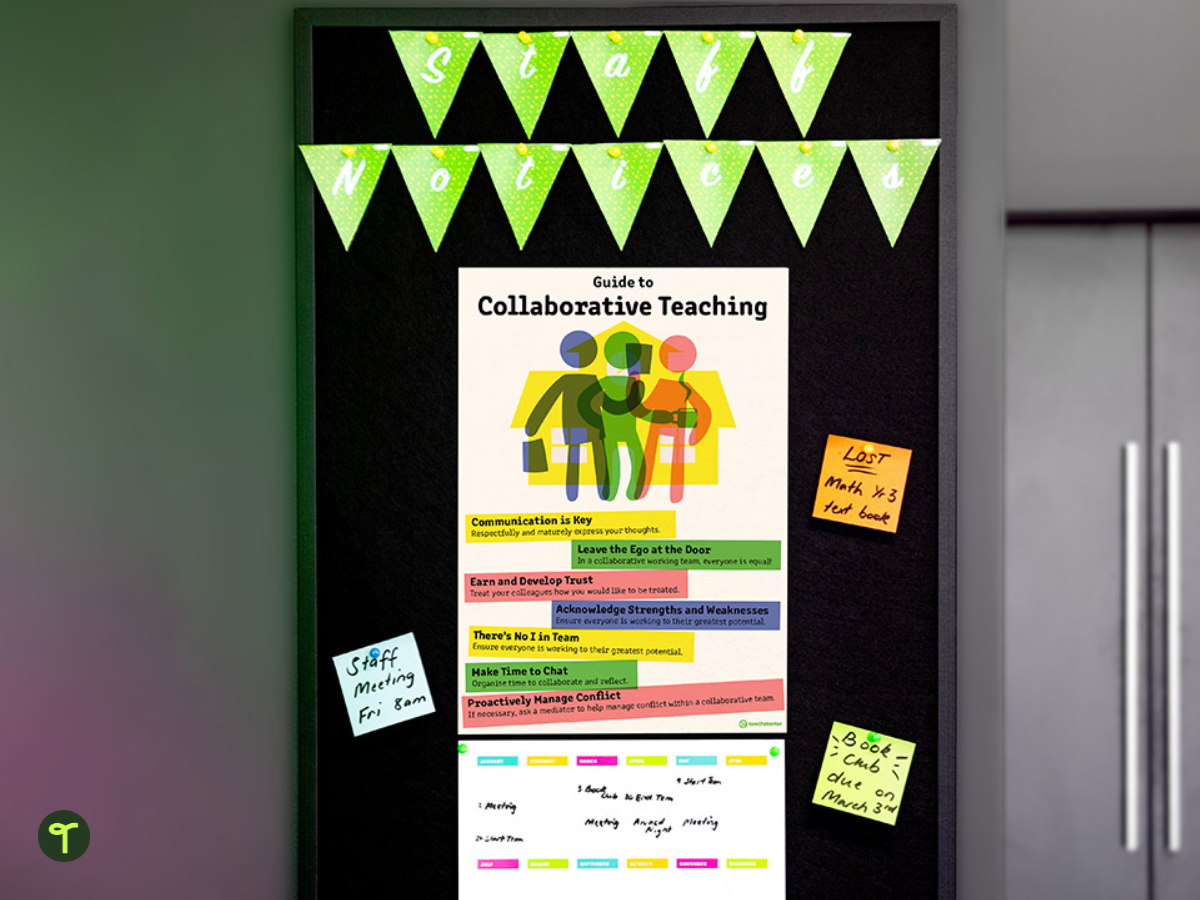When it comes to collaborative teaching, many of us think we have it down pat.
After all, as teachers, we are responsible for teaching the skills of speaking and listening, teamwork and conflict resolution to the next generation.
Every teacher knows that you need your tribe! Collaborating successfully with your fellow teachers is incredibly important for building a solid support network at school.
Collaborative teaching with one or more colleague across the same year level is the status quo in a lot of schools. For schools with one class per grade, being the master of your own ship (or classroom!) does have its upsides, but professional dialogue with your curriculum coordinator or principal is still a necessity.
Like it or not, collaboration is the name of the game in teaching.
Maximising a Collaborative Teaching Relationship
It’s wonderful that so many of us have the opportunity to participate in these supportive professional relationships! But for most of us, there is still much to learn about collaborative teaching before we are able to reach the dream team status that we strive for.
So, how do we go about creating a positive collaborative environment?
There are many points that should be considered when working towards your dream teaching team goals!
Whether you’re working with colleagues that you’ve known for years or learning to collaborate with new friends, sitting down with our Guide to Collaborative Teaching – Poster to facilitate successful discussion is a great place to start. Hang it in your office or staff room for a visual reminder of our top tips for maximising teacher collaboration.

Like most relationships, the most important rule in establishing a supportive and productive professional team is communication. Communicating your thoughts and feelings in a respectful, mature way will be the fastest route to gaining the respect and trust of your colleagues.
Leave the Ego At the Door
First things first. Let’s talk about Ego.
Whether you’re a graduate teacher or a classroom veteran, in a collaborative working team everyone is equal. Everyone will have their own strengths to bring to the table, and experience, no matter how short, is still experience.

Sure, graduate teachers may not have spent much time in the classroom, but they may know about new teaching techniques. Most graduate teachers these days have an online network of professional friends who share innovative ideas and stories. If you write off a graduate teacher just because of their inexperience, you will be losing a very, very valuable source of ideas.
Conversely, a classroom veteran can often be seen as ‘out of touch’, ‘stuck in their ways’ or ‘archaic’. Are you going to write off a wealth of experience with planning, behaviour and classroom management, lesson implementation and assessing just because they aren’t up to date with Instagram?
Didn’t think so.
Use the collaboration experience as a chance to acknowledge you don’t know everything, and you (and your class) will be better for it!
Trust
Once you’ve opened up your mind to the contributions of your colleagues, the next step is to trust in their intentions and allow them to develop trust in you.
Building people’s trust comes easier with some than others. There are a few key points to take note of if you want your co-teachers to trust in you and your suggestions:
- Have professional integrity – by that, I mean take pride and care in what you do. Do your best in all that you do.
- Follow through with your responsibilities.
- Be honest.
- Be punctual.
- Acknowledge and learn from your mistakes.
You would think most of these points go without saying, however as the term gets underway and your planner fills up, it can be easy to let things slide. But you shouldn’t drop the ball with your professional relationships – how would you like it if you’re teaching partner was always ten minutes late to your meetings or didn’t pick up the slack with shared responsibilities?
As the age old saying goes, treat others as you would like to be treated.
Developing a trust-filled partnership with your co-teachers will make your life so much easier in the long run!
Acknowledge Individual Strengths and Weaknesses
Sharing responsibility is one of the easiest ways to save time (and your sanity) with planning. Considering individual strengths and experience when deciding who will take on roles is a great way to make your colleagues feel valued, and ensure everyone is working to their greatest potential. A team in which everyone has expertise in a different area can come together to be something wonderful!
Some areas people may have preference include:
- excursion planning
- assessment and rubric creation
- different Key Learning Areas
- behaviour management.

Perhaps you have a real passion for Geography and your teaching partner is crazy about Science. Why not save time and take on responsibility for planning, assessing and teaching that particular subject to both classes?
If you’re passionate about a topic but choose not to share teaching responsibilities, why not sit in on each other’s classes to gain valuable tips and tricks?
The same goes for weaknesses – if you find technology really tricky to navigate, talk honestly with your colleagues about this. Perhaps there are other responsibilities that you could take on that don’t require you to teach using technology?
Doing the Team Dance
Once you’ve got your responsibilities lain out and planning underway, don’t expect it will all be smooth sailing from there. You still need to figure out how your team will work together day-to-day.
The best way to figure out what will work for everyone is to give a few things a try. Take Numeracy Rotations, for example. Will one or more people plan Numeracy? Will you keep your classes separate, or create shared groups between classes? Will you share your teaching spaces or keep your classrooms separate? One single learning area presents a range of possibilities, and it’s entirely likely that what works best for some, may not work best for others.
Sharing personal preferences is a great way to make sure you are all on the same page.
Consider discussing what your personal preferences are in:
- behaviour management
- planning time
- student outcomes
- parent interactions
- classroom organisation
- lesson content.
While you’re at it, why not share some of your professional goals in the above areas? Your teaching partners can help you strategise a way to achieve your goals. Don’t forget, your colleagues are a great source of professional support!

It will take a while for you and your teaching collaborators to see what works best for you. It’s really all about trial and error and, as I said before, COMMUNICATION.
Scheduling Flow
Once you have the groundwork done and you’ve found a work style that suits you and your colleagues, make sure you actively schedule time to continue collaborative practices.
If you’ve agreed to share teaching responsibilities, classroom space or students, then it goes without saying that you need to have at least a few lessons a week that coincide. Agree on a schedule which is fair for all parties, and stick to it!
Not only will this help your team form long-lasting collaborative habits, but it will set a routine that your students expect and know how to participate in. If you find your kids to go a little crazy for the first few lessons (they are amongst new friends – gasp, shock, horror!) then having a regular schedule and shared ground rules will help them settle sooner rather than later.
The same routine can be beneficial for non-teaching collaborative time. Perhaps your non-teaching lessons align for two sessions a week, and you use one for planning and one for a reflective catch up on how your week has gone? Regular check-ins with your teaching partners ensure you are all on the same page with how your classes and content are working.

On top of this, catch ups provide a great environment for you to check in with your support network. When you spend all day with children, it can be nice to have a grown-up to debrief with once in a while!
Conflict Management
If you find your working relationship isn’t flowing well with you, have a meeting with your colleagues and talk about the issues you’re having.
The best way to approach it is by thinking of some solutions first, and bring these with you to the meeting. If you show you’re proactively working through the issues that you’re having, you’ll show that you’re trying to reach a solution that suits everyone rather than just being a ‘Negative Nancy’. Your team will feel considered and you will be more persuasive!

It is incredibly important to resolve and manage conflict in a timely manner.
If you choose to avoid problems and hope that they will go away, they are more likely to fester and cause issues further down the track.
Similarly, if you prefer to just avoid conflict by letting people get their own way, you are really going to be doing yourself a disservice. As I mentioned before, everyone in a collaborative teaching team is equal! If you do not stand up for yourself, you will not be earning the respect and equality that a teaching team needs to thrive.
Try to think about the conflict resolution strategies you teach to your students – what would you suggest they do? Use their words, listen to the other person, and come up with a plan so that it doesn’t happen again. Easy, right?!
Even if you’ve brought your issues to the team and tried to find a solution collaboratively, you may still find problems popping up. This is the time to reach out for an objective person to become a mediator or offer support separately. Talking over your issues with a listening ear sometimes helps you figure out ways to resolve them yourself!
Maintaining the Dream Team
Once you and your colleagues have ironed out all the wrinkles and are working like a well-oiled teaching machine, make sure you schedule regular check-ins to check your practice and see areas for improvement. There are always ways to evolve and continue improving professional practice!
Make sure you show your teaching team how much you appreciate them and their support on a regular basis. You never realise how wonderful a great collaborative relationship at work is until you don’t have one!







Comments